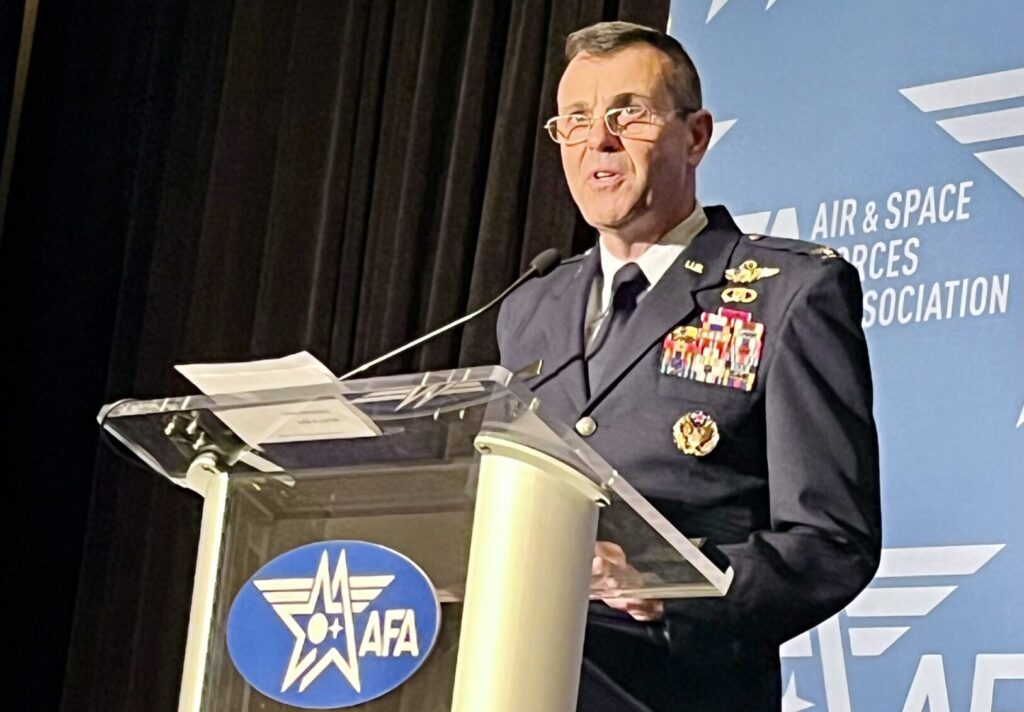By: Dawn Zoldi (Colonel, USAF Ret.)
America’s defense establishment faces what Colonel James Price of Air Combat Command calls “a wicked problem,” one that has fundamentally altered the calculus of air defense: the rapid global proliferation of small, cheap unmanned aerial systems (UAS) and their use in both legitimate and nefarious missions. At the 2025 Air, Space, and Cyber Conference, Colonel Price led a panel of experts from Epirus, L3Harris, Sierra Nevada Corporation (SNC) and Frequentis Defense, in a discussion as to why drone defense has become one of national security’s most formidable and urgent challenges.

Evolving Drone Threats: America’s “Wicked Hard Problem”
Drones now dominate airspace over battlefields, cities and critical infrastructure worldwide. Their propagation has created unique “security challenges,” especially as adversaries rapidly iterate tactics and technology. Colonel Price reminded the audience how Ukraine’s Operation Spider Web dramatically highlighted small drone threats, “successfully destroying multiple strategic aircraft deep inside of Russia.” (See prior AG coverage of Operation Spider Web). Cheap, often untraceable and easy to field in mass, these systems demand “generational evolution in how nations operate,” he emphasized. John Theuerkauf of Frequentis Defense noted the prevalence of UAS for “legitimate missions, by our forces, but also by the public for… delivering packages, everything,” complicates threat identification.
The Drone Defense Dilemma Diagnosis
Asked to characterize the challenge, Michael Hiatt, CTO of Epirus, pointed to how drones “stress every part of the country…” He continued, “Existing missions that we had in terms of air defense” simply don’t apply. Current systems are either “overkill or ineffective” against such threats. “The cost asymmetry drives the narrative,” Hiatt observed. Cheap drones often force expensive responses, whether on the Red Sea or in Ukraine. Jon Piatt, Executive VP, ISR Aviation & Security at SNC, framed drones as, “a wicked problem. “The speed of the threat evolves faster than industry or government can catch up,” he noted.
Drone frequencies now range from 300 MHz up to 6.6 GHz. Adversaries use fiber, earth links and sophisticated navigation. “You have to understand what that drone’s weakness is, and the software evolves so quickly that it becomes really hard to catch up,” Piatt explained.

Tom Kirkland of L3Harris foot-stomped the imperative for open architecture. Modular, plug-and-play platforms must quickly integrate new kinetic and non-kinetic effectors. “As the threat is evolving rapidly, we need to allow our industry to evolve as well… without starting all over again.”
The Policy Maze of Jurisdiction, Compliance and Alliances
The panel detailed policy hurdles, particularly in allied and coalition operations. “Foreign policy is the Achilles heel that keeps us from actually doing something,” said Kirkland. Status of Forces agreements, jurisdictional gaps and local regulations hobble effective defense both at home and abroad. For instance, even deploying radar in a host nation may require navigating myriad FCC and FAA-like agencies around the world. Piatt proposed the “three Cs”: communication, coordination and compliance. “We need to be able to tell [partners] what systems we have… and establish some kind of communication.” Cooperation with the FAA is critical for unmanned traffic management, Theuerkauf added. Otherwise, “we’re not knowing if the drones flying around are rogue or legitimate.” The panel reached consensus that “policy has got to help drive… infrastructures that allow us to exchange data efficiently” between military, law enforcement and industry.
The Escalating Costs of Rebalancing the Cost-Per-Effect Equation
Colonel Price raised a foundational issue: costly, high-tech solutions are unsustainable against swarms of cheap drones. “Instead of shooting multimillion dollar missiles at these things… how do we make this cheaper?” he challenged. (See prior AG coverage from AFA about F-15 pilots shooting down drones). Kirkland described “repurposing munitions” by using existing air-to-ground weapons for drone defense on the ground. “You’re making better use of something that may not come out of the warehouse… that is one way we can get to a cost-effective solution.” Hiatt agreed that deeper magazines, directed energy and “low-cost kinetics” let defenders adapt to mass drone incursions. Panelists also advocated for layered defenses that integrate radar, high-energy lasers, microwaves and kinetic effectors. “Don’t let perfection be the enemy of good enough. We’ve got to get things out now,” said Hiatt.
Technology Solutions: Open Architectures, Layered Defenses
Rapid adaptation requires modular tech. Kirkland explained, “Open architecture allows us to evolve the system itself, allow us to put in multiple effectors, then match effector to kill ratio.” Piatt’s SNC pursues “smart, integrated, intuitive” systems, from radar to software, to help warfighters minimize cognitive burden. “Algorithms that can help… machine learning that can help you do that, that’s what we want to implement,” he stressed.

Hiatt urged a shift from “one versus one” to “one versus many” approach. China’s manufacturing advantage means America “can’t keep up” with drone production; instead, mass effectors like high-power microwave weapons, capable of disabling swarms at once, are key. “A couple of weeks ago we took out 49 drones in less than a second. The only reason it was only 49 is that’s how many we put up,” he explained.
Civilian Integration Beyond the Front Lines
Kirkland made an astute point about the need for civilian counter-UAS. “I’m not thinking about how we train the warfighter. I’m thinking about how we train the civilians,” he said. With drones entering public airspace and critical infrastructure, defense must extend beyond uniformed personnel. “We have to train people who are not warfighters… [with] a simple system that’s agile and translates into the civilian workforce,” he argued.
Data Fusion: Why Situational Awareness is Crucial
Theuerkauf highlighted the importance of integrating civil and military data. “We focus on having a situational awareness that brings in all the different types of radar feeds from the civil side, as well as anything on base, to give the base commanders that oversight.” Such networked architectures ensure centralized command and quick response across locations. Kirkland described “expanded network integration” and “distributed defense networks,” which improve kill probabilities and optimize the kill chain in real time.
Solving the Wicked Hard Problem
As America confronts the “wicked hard problem” of drone defense, the takeaways from this panel resonate: adapt rapidly, build open platforms, invest in layered defenses and integrate both civilian and military assets. Scaling up means moving beyond one-to-one defenses to effectors and solutions that keep ahead of mass drone swarms. The challenge remains multi-dimensional, with policy, technology, cost, and civilian engagement all entwined. Colonel Price closed a call to arms, “It’s going to take a lot of people to get this done.” This wicked problem is here to stay. The only question is how quickly America can align its policies, technologies and people to meet it head-on.

